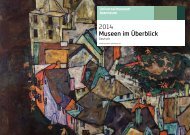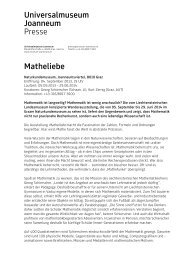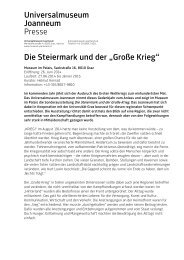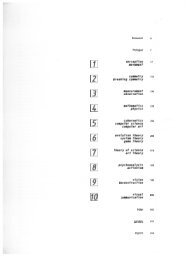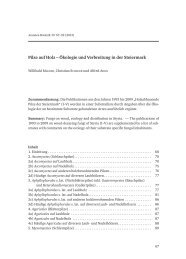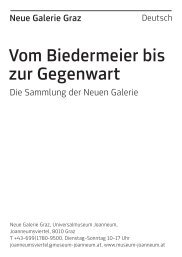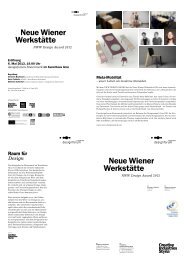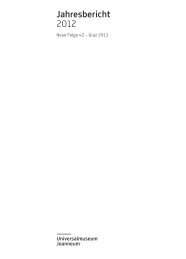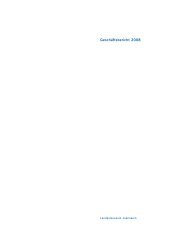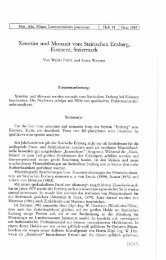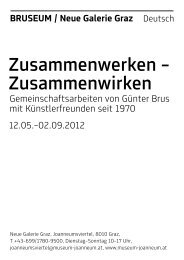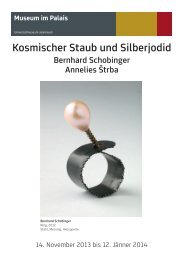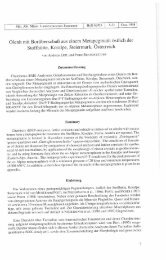Katalog/Catalogue - deutsch/englisch
Katalog/Catalogue - deutsch/englisch
Katalog/Catalogue - deutsch/englisch
Sie wollen auch ein ePaper? Erhöhen Sie die Reichweite Ihrer Titel.
YUMPU macht aus Druck-PDFs automatisch weboptimierte ePaper, die Google liebt.
Wissen + Fühlen/oben + unten:<br />
ein Codesystem für Form und Bedeutung<br />
Das japanische Wort „chikaku“, oft mit Wahrnehmung übersetzt,<br />
ist aus zwei Wörtern zusammengesetzt: aus „chi“, was<br />
soviel bedeutet wie „wissen“, und „kaku“, „fühlen“. „Chi“ ist in<br />
Wörtern wie „chishiki“ (Wissen), „chie“ (Weisheit) und „chinou“<br />
(Intelligenz) enthalten und bezeichnet das rationale Denken.<br />
Im Gegensatz dazu bedeutet „kaku“ das Spüren mit den fünf<br />
Sinnen wie in „kankaku“ (Sensibilität), „mikaku“ (Geschmack)<br />
und „genkaku“ (Halluzination). In gängigen Wörterbüchern<br />
findet man für „chikaku“ zwei Bedeutungen:<br />
1 Wissen und Verstehen erlangen durch den Intellekt<br />
2 Dinge und Ereignisse der Außenwelt als etwas Integrales<br />
und Bedeutungsvolles zu begreifen durch die Stimulanzhandlung<br />
der Sinnesorgane (aus: Daijirin)<br />
Um es einfach zu sagen, „chi“ deutet ein logisches Verständnis<br />
der Außenwelt an, während „kaku“ auf deren sinnliches<br />
Erkennen verweist. In „chikaku“ finden „Verstehen“ und „Fühlen“<br />
gleichzeitig statt. Die Wolken am Himmel betrachten und ihre<br />
Schönheit empfinden, um im nächsten Moment sich zu fragen,<br />
wie es möglich ist, dass diese Wolken überhaupt am Himmel<br />
schweben, während man weiter träumt und die Wolken ihre<br />
Gestalt ändern. Dieses unmittelbare Hin und Her zwischen<br />
„chi“ und „kaku“ stellt den endlosen Wechselprozess dar – wie<br />
der flimmernde Bildschirm eines Monitors –, der die Gesamtheit<br />
dessen, was wir als „Erkennen“ bezeichnen, hervorbringt.<br />
Der Umgang mit dem Dreidimensionalen und dem Zweidimensionalen<br />
durch die Trennung von oberer und unterer Ausstellungsebene<br />
stellt ohne Zweifel eine Trennung der beiden Aspekte<br />
dieser einen gleichzeitig stattfindenden Handlung dar, die<br />
sich dann wieder überlagern. (Unnötig zu erwähnen, dass die<br />
Elemente des einen jeweils im anderen enthalten sind.)<br />
Wie es das aus „chi“ und „kaku“ zusammengesetzte japanische<br />
Wort ausdrückt, stellt die Gestaltung der Ausstellung mit den<br />
beiden Elementen „oben“ und „unten“ ein Moment von „chikaku“<br />
dar. So sind auch die japanischen Schriftzeichen immer angeordnet<br />
worden: nicht horizontal, sondern vertikal, eines über<br />
dem andern.<br />
Die geschriebene japanische Sprache ist eine Kombination<br />
von ideografischen „kanji“- und phonografischen „kana“-Zeichen.<br />
Makoto Sei Watanabe 46 47<br />
1 To achieve knowledge and understanding through the<br />
intellect<br />
2 To grasp events and things in the external world as<br />
something integrated and meaningful through the stimulant<br />
action generated by the sensory organs (from Daijirin)<br />
To put it simply, “chi” strongly infers a logical understanding<br />
of the external world while “kaku” infers a sensory<br />
recognition of the external world. In “chikaku”, “reading”<br />
and “sensing” take place simultaneously. Looking up at<br />
the clouds in the sky and thinking how beautiful they<br />
are and then in the next moment wondering how these<br />
clouds manage to float in the sky, meanwhile continuing<br />
to revel in the clouds which continue to change shape and<br />
form. The instantaneous moving back and forth between<br />
“chi” and “kaku” represents a never-ending switching<br />
process – like the flickering screen of a monitor – that<br />
creates the overall image that is “recognition”.<br />
The addressing of the three-dimensional and the twodimensional<br />
by separating them into the upper and lower<br />
levels in this exhibition arguably represents a separation<br />
of the two aspects of the single action that take place<br />
simultaneously and then, once again, superimposing one<br />
onto the other. (Needless to say, the components of both<br />
are included in both.)<br />
As expressed by the Japanese word formed by the characters<br />
for “chi” and “kaku”, the exhibition design also<br />
forms an instance of “chikaku” through the two elements<br />
of “upper” and “lower”. That‘s how these Japanese script<br />
characters have always been arranged — not horizontally,<br />
but vertically one above the other.<br />
The Japanese written language is a combination of the<br />
ideographic writing “kanji” and the phonographic writing<br />
“kana”. As each of the “kanji” characters – imported<br />
from China around 1600 years ago – has its own meaning,<br />
the form and meaning of “kanji” is perceived as<br />
something that is inextricably linked. Meanwhile, “kana”<br />
characters which were developed in Japan around 1100<br />
years ago simply express sound and therefore have no<br />
relationship to form or meaning.<br />
For example, when looking at the “kanji” for “water”<br />
the character conveys the image and concept of water



